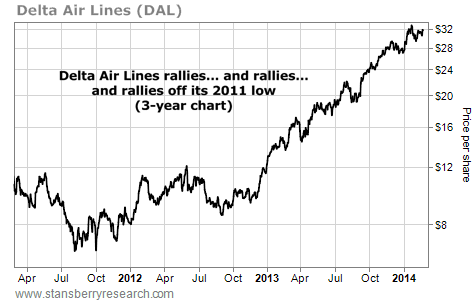| Home | About Us | Resources | Archive | Free Reports | Market Window |
The Best Way to Make Money in Foreign MarketsBy
Tuesday, February 25, 2014
What's the best way to make money in stocks?
Which investing strategy works the best?
How about a strategy that turned $10,000 into $1.8 billion – by simply buying stocks?
$10,000 invested would have turned into $1,838,450,713 by investing in a "shareholder yield" strategy from 1928 through 2009... That's according to Jim O'Shaughnessy's book, What Works on Wall Street.
This strategy would have trounced the stock market for decades... with less volatility. That's exactly what you want to invest in...
O'Shaughnessy's shareholder yield strategy involves buying stocks that return cash to shareholders through dividends and share buybacks – when they're in an uptrend.
O'Shaughnessy found that it was one of the top-performing strategies in history (out of hundreds that he tested).
The term "shareholder yield" describes how much of a company's cash flow it's giving back to shareholders... The more a company is giving back to shareholders, the higher the return shareholders have made over history.
Last summer, I told DailyWealth readers about a simple fund my good friend Mebane Faber created to take advantage of this concept. The fund is called the Cambria Shareholder Yield Fund (SYLD)... and it has outperformed the U.S. stock market by around 5.5% since launching last May.
Recently, Meb launched another fund to capitalize on this investment system... OUTSIDE the U.S...
Meb's new fund is the Cambria Foreign Shareholder Yield Fund (FYLD). Its goal is identical to SYLD... but with a global focus.
The majority of the stocks in this fund are from Europe. And they are cheap... Specifically, the fund's average forward price-to-earnings (P/E) ratio is just 12.2, which is significantly cheaper than U.S. stocks. (The forward P/E on U.S. stocks is averaging 14.0.)
The fund's holdings have an average dividend yield of about 5% (versus a 2% dividend in U.S. stocks). On top of that, these companies are buying back shares. (Remember, buybacks are good because they reduce the number of shares outstanding... So mathematically, buybacks increase the earnings per share.)
Shares of the Cambria Foreign Shareholder Yield Fund accomplish two things: 1) They pay you a high dividend. (I expect it will be in the 4%-5% range, paid quarterly, with the first payment coming in March.) 2) They give you exposure to the dirt-cheap values in Europe.
The companies in this fund are doing the right thing for shareholders. They are cheap, they pay high dividends, and they have significant upside potential.
History is clear… Buying companies based on shareholder yield beats the market... with less volatility. That's exactly what we want...
Right now, Europe offers better values than the U.S. And my friend Meb's new fund, FYLD, allows you to easily put our shareholder-yield ideas to work outside of the U.S.
Check it out... For more, visit www.CambriaFunds.com.
Good investing,
Steve
Further Reading:
In one of our best Stansberry Radio interviews ever, Meb talked to Porter Stansberry and Aaron Brabham about shareholder yield, global investing, and where the best opportunities are today. Listen to the episode (or download the transcript) right here.
Shareholder yield is a combination of buybacks and dividends. And while most people think dividends are the key to investing, buybacks are actually much more important. Steve Sjuggerud says it's like getting a "stealth dividend," and it's one of his favorite ways to beat the market. Learn more about stealth dividends – and a simple, "one click" way to start collecting them – here.
Market NotesAIRLINE STOCKS ARE STILL CLIMBING Today's chart proves you can make great money in bad businesses... You just have to approach them with a "bad to less bad" strategy in mind...
Back in September 2011, we noted the trouble with airline stocks. Airlines sport tiny profit margins, they're subjected to big swings in fuel costs, and they require lots of ongoing investment just to keep the business running. This makes them terrible long-term investments. But from a trading viewpoint, we noted that airlines go through big "boom and bust" cycles. These cycles can be traded for big profits.
In our write-up, we noted that airlines had just experienced a big bust. Many airline names, like giant Delta Air Lines (DAL), had lost over 40% of their value in just a few months. Sentiment toward the sector was awful. This, we speculated, offered a chance to trade a "bad to less bad" rally (read our educational interview for more details on this approach).
As you can see from the chart below, the airline sector has rallied... and rallied... and rallied some more. We wrote our bullish note in late 2011 when Delta traded for around $8 per share. It then rallied to $15 per share... then $25 per share. And just recently, it traded over $31 (a gain of nearly 300%). It's one heck of a "bad to less bad" move.
 |
Recent Articles
|


